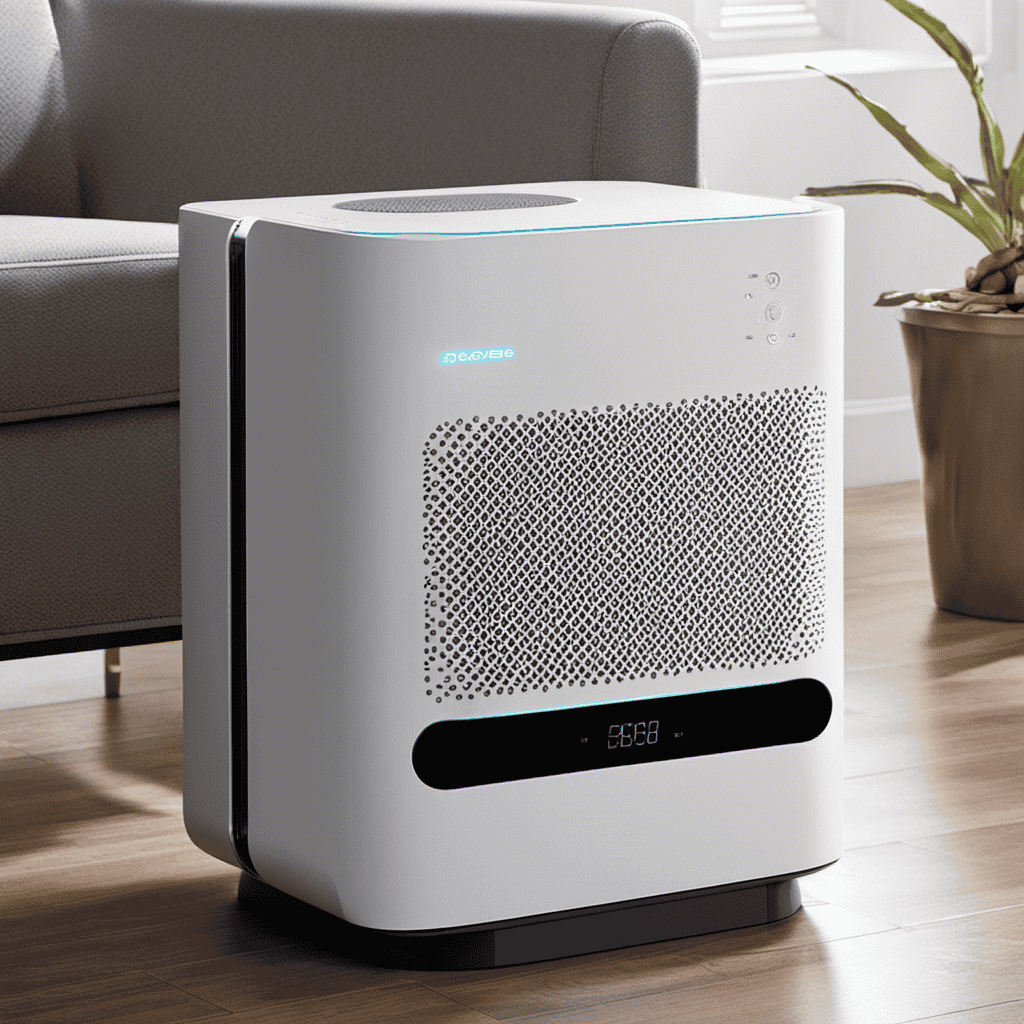As an air quality enthusiast, I can tell you that the science behind air purification is truly fascinating. It’s incredible how we can use technology to filter out harmful particles and improve the air we breathe.
In this article, I will delve into the importance of air quality and the role of particulate matter. We will explore the various air purification technologies available and understand the science behind HEPA filters.
Let’s uncover the impact of indoor air pollution and how we can combat it.
Key Takeaways
- Air quality has significant health effects on our bodies, including respiratory problems and exacerbating existing health conditions.
- Particulate matter, which includes tiny particles suspended in the air, can trigger or worsen respiratory conditions and is mainly caused by human activities.
- Various air purification methods, such as HEPA filters, activated carbon filters, and UV germicidal irradiation, target specific air pollutants and remove them from the indoor environment.
- HEPA filters, with their dense web of fibers and multiple layers of filtration material, have a high efficiency rating and can remove particles as small as 0.3 microns in size.
The Importance of Air Quality
Air quality is crucial for maintaining a healthy environment. The quality of the air we breathe has significant health effects on our bodies. Poor air quality can lead to respiratory problems, such as asthma and allergies, and can also exacerbate existing health conditions like cardiovascular disease. The presence of pollutants in the air, such as particulate matter, ozone, and nitrogen dioxide, can have detrimental effects on our respiratory systems and overall well-being.
On the other hand, good air quality provides numerous environmental benefits. It promotes the health of ecosystems, preserves biodiversity, and supports the growth of plants and crops. Clean air is essential for the well-being of animals, including humans. It is also crucial for the maintenance of water and soil quality. Additionally, improving air quality can help mitigate climate change by reducing the emission of greenhouse gases and improving energy efficiency.
The Role of Particulate Matter
Particulate matter plays a crucial role in determining the air quality. It refers to tiny particles suspended in the air, which can have significant impacts on our health and the environment. Here are some key points to consider:
-
Particulate matter can have detrimental health effects, especially when it enters our respiratory system. It can trigger or worsen respiratory conditions such as asthma, bronchitis, and even heart problems.
-
The sources of particulate matter are diverse and can be both natural and human-made. Natural sources include dust, pollen, and volcanic eruptions. Human activities such as industrial processes, vehicle emissions, and burning of fossil fuels contribute to the majority of particulate matter in urban areas.
-
The size of particulate matter is crucial in determining its health effects. Fine particles, known as PM2.5, are smaller than 2.5 micrometers and can penetrate deep into our lungs, while coarse particles, known as PM10, are larger and tend to get trapped in our upper respiratory system.
-
The composition of particulate matter varies depending on its source. It can contain toxic substances such as heavy metals, organic compounds, and pollutants like nitrogen oxides and sulfur dioxide.
-
Reducing our exposure to particulate matter is essential for maintaining good air quality. This can be achieved through measures like using air purifiers, wearing masks in polluted areas, and implementing regulations to control emissions from industrial sources and vehicles.
Understanding the role of particulate matter is crucial in addressing air pollution and safeguarding our health. By taking action to reduce its sources and protect ourselves, we can contribute to a cleaner and healthier environment.
Understanding Air Purification Technologies
When it comes to improving indoor air quality, understanding different air purification technologies is essential. There are various air purification methods available today, each designed to target specific air pollutants and remove them from the indoor environment. To help you understand these technologies better, let’s take a look at a comparison table:
| Air Purification Method | Air Pollutant Removal |
|---|---|
| HEPA Filters | Particulate matter |
| Activated Carbon Filters | Volatile organic compounds (VOCs) |
| UV Germicidal Irradiation | Bacteria and viruses |
| Electrostatic Precipitators | Smoke and fine particles |
| Ionizers | Allergens and airborne particles |
HEPA filters are highly effective in removing particulate matter, such as dust, pollen, and pet dander. Activated carbon filters excel at eliminating volatile organic compounds (VOCs), which are commonly found in cleaning products and furniture. UV germicidal irradiation utilizes ultraviolet light to kill bacteria and viruses, providing a clean and sterile environment. Electrostatic precipitators are ideal for removing smoke and fine particles, making them useful in areas with high levels of indoor air pollution. Ionizers release negatively charged ions that attach to allergens and airborne particles, causing them to settle and be easily removed from the air.
The Science of HEPA Filters
HEPA filters are highly effective at removing dust, pollen, and pet dander from the indoor environment. These filters work by using a combination of physical and mechanical mechanisms to trap and capture airborne particles.
Here’s why HEPA filters are so effective:
-
They have a dense web of fibers: HEPA filters are made up of interlaced fibers that create a maze-like structure. This design allows them to effectively capture even the smallest particles.
-
They use the principle of diffusion: As air passes through the filter, particles collide with the fibers due to diffusion. This causes them to become trapped and unable to escape back into the air.
-
They have multiple layers: HEPA filters are often composed of multiple layers of filtration material. This ensures that particles are captured at various stages, increasing the overall effectiveness of the filter.
-
They have a high efficiency rating: HEPA filters are required to meet strict standards set by the United States Department of Energy. These standards ensure that the filters are highly efficient and capable of removing particles as small as 0.3 microns in size.
-
They are tested and certified: HEPA filters undergo rigorous testing to ensure their performance. Certification from organizations such as the True HEPA Filter Association guarantees that the filter meets the necessary standards.
HEPA filters are an essential tool in combating indoor air pollution. They effectively remove harmful particles, improving the quality of the air we breathe.
In the following section, we will explore the impact of indoor air pollution and why it is crucial to address this issue.
The Impact of Indoor Air Pollution
Indoor air pollution can have detrimental effects on our health and well-being. The health effects of indoor air pollution are numerous and can be severe. According to the World Health Organization (WHO), exposure to indoor air pollution can lead to respiratory diseases such as asthma, bronchitis, and even lung cancer. Additionally, it can worsen existing conditions like allergies and cause symptoms such as coughing, wheezing, and shortness of breath.
The sources of indoor air pollution are varied and can be found in everyday household items. Common sources include tobacco smoke, cooking and heating appliances, cleaning products, building materials, and even outdoor pollutants that enter the home through ventilation systems or open windows. These sources release harmful pollutants into the air, such as volatile organic compounds (VOCs), carbon monoxide, nitrogen dioxide, and particulate matter.
To mitigate the health effects of indoor air pollution, it is crucial to identify and minimize exposure to these pollutants. This can be done through proper ventilation, regular cleaning, and maintenance of appliances, using natural cleaning products, and avoiding smoking indoors. Additionally, air purifiers with HEPA filters can help remove harmful particles and improve indoor air quality.
Frequently Asked Questions
Are Air Purifiers Effective in Removing All Types of Indoor Air Pollutants, Including Volatile Organic Compounds (Vocs) and Gases?
Air purifiers are effective in removing various indoor air pollutants, including volatile organic compounds (VOCs) and gases. They play a crucial role in reducing indoor air pollution and improving respiratory health.
These devices use filters and other purification methods to trap and eliminate harmful particles, allergens, and odors from the air.
Numerous studies have shown the positive impact of air purifiers on respiratory health, providing evidence of their effectiveness in creating a cleaner and healthier indoor environment.
How Often Should I Replace the Filters in My Air Purifier?
Replacing the filters in your air purifier is crucial for maintaining its effectiveness. The frequency of replacement depends on factors like the air quality in your environment and the type of filter you use.
Generally, HEPA filters should be replaced every 6-12 months, while carbon filters may need to be replaced more frequently. Regularly checking the manufacturer’s recommendations and monitoring the quality of the air in your space are key to ensuring your air purifier is working optimally.
Can Air Purifiers Help Alleviate Allergy Symptoms Such as Sneezing and Watery Eyes?
Yes, air purifiers can help alleviate allergy symptoms like sneezing and watery eyes. They are effective in reducing asthma symptoms and improving indoor air quality.
Studies have shown that air purifiers can filter out allergens such as dust, pollen, and pet dander, which can trigger allergies. By removing these particles from the air, air purifiers can provide relief for allergy sufferers.
It is important to choose an air purifier with a HEPA filter, as they are most effective in capturing these allergens.
Are There Any Potential Health Risks Associated With Using Air Purifiers for Extended Periods of Time?
There may be potential side effects and long-term effects associated with using air purifiers for extended periods of time.
It is important to consider factors such as the type of air purifier, the quality of the air being filtered, and individual sensitivities.
Some people may experience dryness or irritation in the throat, nose, or eyes.
Additionally, certain air purifiers may produce ozone, which can have detrimental health effects when inhaled in high concentrations.
It is crucial to research and choose the right air purifier for your specific needs.
Can Air Purifiers Eliminate Odors From Cooking, Pets, or Smoke?
Air purifiers are like superheroes for your home. They swoop in, using their powerful filters to rid the air of unwanted odors from cooking, pets, and smoke.
Not only do they leave your space smelling fresh, but they also improve indoor air quality by removing harmful particles.
However, it’s important to consider their impact on energy consumption. Finding a balance between clean air and energy efficiency is key.
Conclusion
In conclusion, the science behind air purification is like a knight in shining armor, valiantly fighting against the invisible enemies that pollute our indoor air.
With the power of HEPA filters and other advanced technologies, it acts as a shield, protecting us from the harmful particulate matter that lurks in our living spaces.
By understanding the importance of air quality and the impact of indoor air pollution, we can embrace the science of air purification and breathe easier, knowing that our health and well-being are safeguarded.




